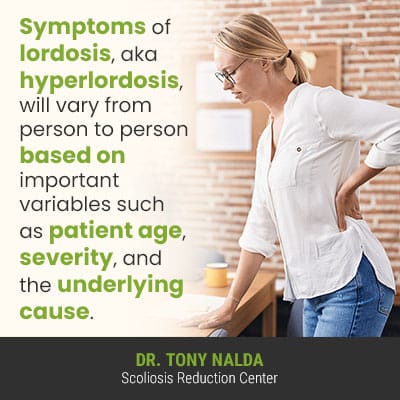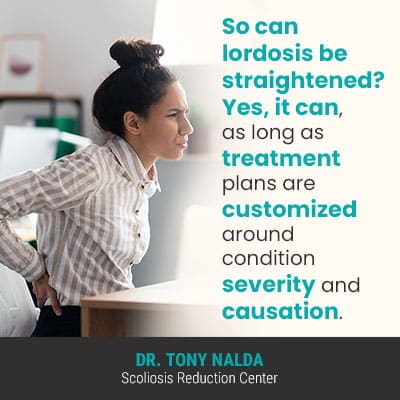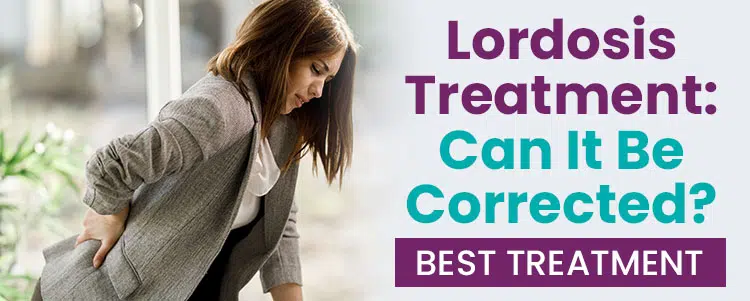When it comes to the loss of a healthy spinal curve, this disrupts the biomechanics of the entire spine; the integrity of each natural curve is dependent upon the health of the others. Keep reading to learn more about the connection between the spine’s healthy curves and maintaining optimal spinal function.
The spine’s natural curves make it stronger, more flexible, and better able to absorb/distribute mechanical stress. The spine’s C-shaped curve at the neck and lower back are known as lordosis; lordosis is a type of spinal deformity characterized by an exaggerated inward curve of the spine. When the spine’s natural lordosis becomes over-pronounced, it’s also known as lordosis or hyperlordosis.
Before getting to the specifics of lordosis, and excessive lordosis (hyperlordosis), let’s first explore some basic spinal anatomy.
Anatomy of the Spine
The spine has three main sections: cervical (neck), thoracic (middle/upper back), and lumbar (lower back).
In a healthy spine, the vertebrae (bones of the spine) are stacked on top of one another in a straight and neutral alignment, and as long as those vertebrae stay aligned, the spine’s natural curvatures are maintained.
The vertebrae are separated by intervertebral discs that perform many important roles in facilitating spinal function: providing cushioning between adjacent vertebrae, enabling flexible movement, providing the spine with structure (adjacent vertebrae attach to the disc in between), and acting as the spine’s shock absorbers.
Intervertebral disc issues are at the root of many spinal-condition causes, including lumbar lordosis.
Postural lordosis can develop due to poor posture and muscle imbalances, leading to an exaggerated inward curve of the spine.
When viewed from the front or back, healthy spines will appear straight, and when viewed from the side, it has a soft ‘S’ shape; that’s because of the spine’s healthy curves known as lordosis and kyphosis.
What is Lordosis?
The spine’s inward curves that bend forward, towards the body’s center in a ‘C’ shape, are known as lordosis, while the curvatures that bends backward, away from the body’s center, in a reverse ‘C’ shape, are known as kyphosis.
The spine’s cervical and lumbar sections feature lordotic curves that bend inwards, while the thoracic spine (middle/upper back) bends outwards: a kyphotic curve.
Now, there is a normal and natural range of lordosis and kyphosis, but when a person’s degree of curvature falls beyond a normal range, problems can occur.
A normal range of lordosis in the cervical spine is between 20 and 35 degrees, and a range of lumbar lordosis would fall between 40 and 60 degrees; the spine’s thoracic kyphosis would fall in the range of 20 to 40 degrees.
In the medical world, the term lordosis is used interchangeably with hyperlordosis to refer to both a normal range, and excessive lordosis that falls beyond a healthy range as hyperlordosis.
While hyperlordosis can affect both the cervical and lumbar spinal sections, it most commonly involves the lumbar spine, so that’s the condition type we’ll focus on.
Certain factors such as poor posture, obesity, and muscle imbalances can cause individuals to develop lordosis.
So if a person develops excessive lordosis in their lower back, what are some of the likely symptoms?
Lumbar Lordosis Symptoms
Symptoms of lordosis, aka hyperlordosis, will vary from person to person based on important variables such as patient age, severity, and the underlying cause.
Common symptoms can include lower back (lumbar lordosis) or neck (cervical lordosis) pain.
Additional symptoms of cervical include neck-muscle pain and shoulder pain from muscles being pulled in different directions; the muscles that surround the spine help it to stay aligned and maintain its natural curves and alignment.
A reduced range of motion in the affected area is also common, as are sore muscles as they struggle to support and stabilize a spine with an unnatural curvature.
For people with lumbar lordosis, lying with the back flat on the floor is impossible; regardless of position change, there will always be a gap between the lower back and the floor because of the excessive lordosis.
The condition is also referred to as swayback because of the postural changes it’s associated with: a protruding stomach and buttocks.

Additional symptoms can include:
- Numbness
- Tingling sensations in the lower back and throughout the lower body
- Electric shock-like pains
- Weakness in the lower back and abdominal muscles
- Chronic low back pain
- Difficulty with bowel or bladder control
- Difficulties with muscle control in the area
Additional symptoms can include:
- Numbness
- Tingling sensations in the lower back and throughout the lower body
- Electric shock-like pains
- Weakness in the lower back and abdominal muscles
- Chronic low back pain
- Difficulty with bowel or bladder control
- Difficulties with muscle control in the area
In cases of severe lordosis, individuals may experience significant pain, numbness, and even loss of bladder control, necessitating immediate medical attention.
If the hyperlordotic spinal curve is causing compression, it can impact surrounding nerves, producing a myriad of symptoms that can be felt in the lower back and throughout the lower body.
Common causes of lordosis include poor posture, obesity, leading a sedentary lifestyle, and the presence of other spinal conditions such as kyphosis (compensatory curves), discitis, and spondylolisthesis.
So once a diagnosis of lordosis is given, what can be done about it?
Additional symptoms can include:
- Numbness
- Tingling sensations in the lower back and throughout the lower body
- Electric shock-like pains
- Weakness in the lower back and abdominal muscles
- Chronic low back pain
- Difficulty with bowel or bladder control
- Difficulties with muscle control in the area
In cases of severe lordosis, individuals may experience significant pain, numbness, and even loss of bladder control, necessitating immediate medical attention.
If the hyperlordotic spinal curve is causing compression, it can impact surrounding nerves, producing a myriad of symptoms that can be felt in the lower back and throughout the lower body.
Common causes of lordosis include poor posture, obesity, leading a sedentary lifestyle, and the presence of other spinal conditions such as kyphosis (compensatory curves), discitis, and spondylolisthesis.
So once a diagnosis of lordosis is given, what can be done about it?
Understanding Lordosis
Lordosis is a medical term that refers to an abnormal inward curvature of the spine. This condition can manifest in the lower back (lumbar spine) or the neck (cervical spine), leading to an exaggerated inward curve that can cause discomfort, pain, and limited mobility. The lumbar spine’s natural curve helps to support the weight of the upper body, but when this curve becomes too pronounced, it can lead to a condition known as lumbar lordosis. Similarly, an exaggerated inward curve in the cervical spine results in cervical lordosis.
Several factors can contribute to the development of lordosis, including poor posture, muscle imbalances, obesity, and congenital conditions. For instance, prolonged periods of sitting or standing with improper posture can strain the spine and lead to an abnormal spinal curvature. Additionally, weak abdominal muscles and tight lower back muscles can exacerbate the condition, making it essential to address these muscle imbalances through targeted exercises and physical therapy.
Definition and Explanation
Types of Lordosis
Lumbar Lordosis
Lumbar lordosis specifically affects the lower back, or lumbar spine. This type of lordosis is characterized by an exaggerated inward curve of the lumbar spine, which can cause the abdomen to protrude and the pelvis to tilt back and up. This abnormal spinal curvature can result from various factors, including poor posture, muscle imbalances, and obesity. Individuals with lumbar lordosis may experience symptoms such as lower back pain, muscle strain, and even difficulty breathing due to the altered alignment of the spine.
The condition can also lead to a noticeable change in posture, often referred to as “swayback,” where the lower spine curves excessively inward. Addressing lumbar lordosis typically involves a combination of lifestyle modifications, physical therapy, and exercises designed to strengthen the abdominal muscles and improve overall spinal alignment.
Cervical Lordosis
Cervical lordosis affects the neck, or cervical spine, and is characterized by an exaggerated inward curve of the cervical spine. This condition can lead to neck pain, muscle tightness, and a limited range of motion. Common causes of cervical lordosis include poor posture, muscle imbalances, and trauma, such as whiplash from a car accident. Individuals with cervical lordosis may experience symptoms such as neck pain, headaches, and difficulty moving the neck.
Treatment for cervical lordosis often involves physical therapy to address muscle imbalances and improve posture. Exercises that strengthen the neck and upper back muscles can help reduce pain and restore a more natural spinal curvature. In some cases, ergonomic adjustments to workstations and daily activities may also be necessary to prevent further strain on the cervical spine.
By understanding the different types of lordosis and their respective causes and symptoms, individuals can take proactive steps to manage and treat this condition, ultimately improving their spinal health and overall quality of life.
Can Lordosis be Corrected?
To effectively treat lordosis correction, a customized treatment plan has to be crafted around a condition’s underlying cause.
For the condition’s most-common cause, the cumulative effect of certain lifestyle choices, I would provide my patients with lifestyle guidance that addresses relevant postural issues.
When lordosis is diagnosed, a thorough medical history and physical examination are essential to confirm the condition. When lordosis is caused by the presence of an underlying spinal condition, the spinal condition will be the guiding force of treatment.
Here at the Scoliosis Reduction Center®, I approach treatment for a variety of spinal conditions by focusing on their underlying cause; otherwise, only symptoms of the condition are being addressed and not the condition itself.
The distinction between treating symptoms, or the condition itself, is an important one because in traditional general medicine, too often, prescription medications are handed out for a quick fix, and while these can bring short-term pain relief, they do little in terms of proactively addressing the pain’s underlying cause for long-term sustainable pain relief.
In addition, masking symptoms with pain medications can be dangerous because it can hide increasing condition severity and the need for treatment.
When lifestyle guidance is needed, as positive changes are made in terms of posture, weight, and exercise, we address the condition’s underlying cause, and related symptoms such as pain or postural changes are also addressed throughout the course of treatment. Lordosis treated by a spine specialist may involve close monitoring, especially during growth spurts, and addressing any underlying conditions.
A large part of addressing problematic lifestyle issues is introducing condition-specific exercises such as lumbar-stabilization exercises known to increase lumbar muscle strength, and muscle flexibility and reduce the load on the spine.
When lumbar lordosis is caused by kyphosis in another area of the spine, this is related to the development of compensatory curves. As the spine’s degree of kyphosis is problematic, it tries to counteract its effects by introducing a compensatory lordotic curve; while working towards restoring the spine’s natural kyphosis, the spine’s biomechanics are improved, in addition to any compensatory lordotic curves.
When an intervertebral disc issue such as discitis is the cause, the health and function of the discs have to be restored, and when successful, the spine becomes more stable as it’s realigned and disc health is improved. Traumatic lordosis, resulting from severe injury, requires prompt medical evaluation to address damaged vertebral structures and ligaments.
When spondylolisthesis is the cause, restoring as much of the spine’s healthy curves and alignment through corrective bracing, condition-specific chiropractic adjustments, physical therapy, and rehabilitation can help reduce related lordosis.
Our approach at the Center is conservative, chiropractic-centered, and involves integrating multiple forms of treatment, so spinal conditions are impacted on multiple levels.
When considering lordosis treatment and whether it can be corrected, it’s important to recognize that the outcome depends on the specific case and factors such as the degree of the spinal curve and the presence of sagittal imbalance
While mild cases of lordosis may improve with exercises and physical therapy, more severe instances might require a kyphosis back brace to help maintain proper spinal alignment and alleviate discomfort. The possibility of correction varies, and healthcare professionals will assess each individual’s condition to determine the most suitable approach for managing and potentially improving lordosis.
Lumbar scoliosis and flatback syndrome can impact the natural curvature of the spine, but with proper lordosis treatment and medical intervention, it is possible to correct or manage these conditions to improve spinal alignment and overall comfort.
So can lordosis be straightened? Yes, it can, as long as lumbar lordosis treatment plans are customized around condition severity and causation.

Conclusion on Abnormal Spinal Curvature
When it comes to addressing what the best treatment for lordosis is, the answer will be case-specific based on patient age, condition severity, and the underlying cause of the excessive lumbar lordosis.
Commonly referred to as swayback, the exaggerated inward C-shaped curvature of the lumbar spine can cause the abdomen and buttocks to protrude excessively, giving the body a swayback appearance.
As the spine is such an important part of human anatomy, conditions that involve a loss of its healthy spine curves, such as lordosis, aka hyperlordosis, can cause a myriad of symptoms, particularly if left untreated.
When it comes to preserving spinal health and function, prevention by practicing a spine-friendly lifestyle, including maintaining a healthy weight and activity level, practicing good posture, and understanding the ergonomics of heavy lifting, can stave off the development of a number of spinal issues/conditions.
When it comes to lordosis that develops because of an underlying spinal condition such as kyphosis, discitis, or spondylolisthesis, the spinal condition that caused the lordosis needs to be treated proactively, so the related complication of excessive lumbar lordosis is addressed simultaneously.
Here at the Scoliosis Reduction Center®, I integrate multiple treatment disciplines such as chiropractic care, in-office therapy, custom-prescribed home exercises, and corrective bracing to impact a variety of spinal conditions, lordosis included, on multiple levels.
If you, or someone you care about, are concerned with the possible development of an unnatural spinal curve, don’t hesitate to reach out for further guidance, support, and assessment.




